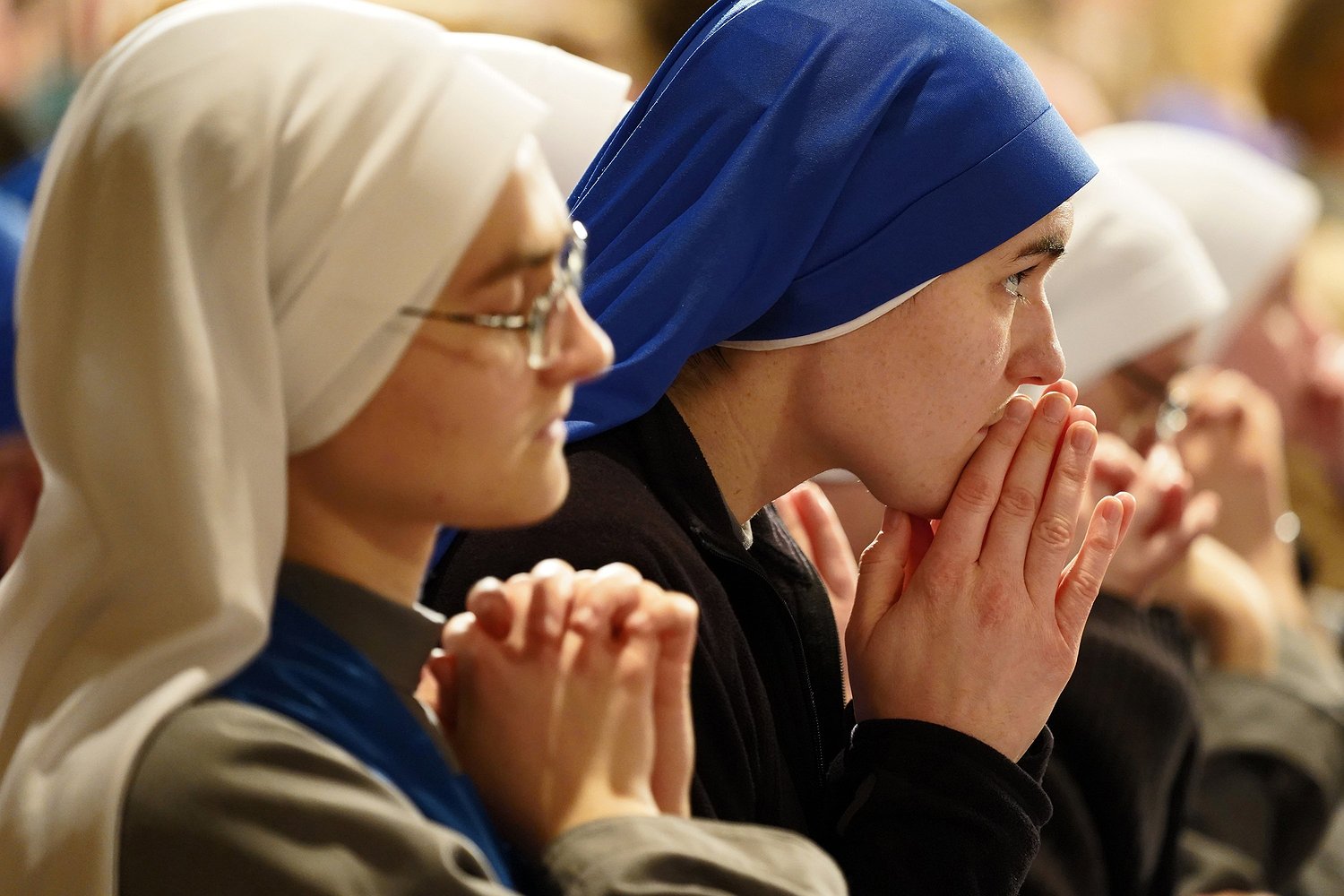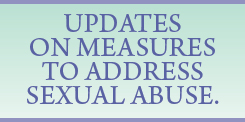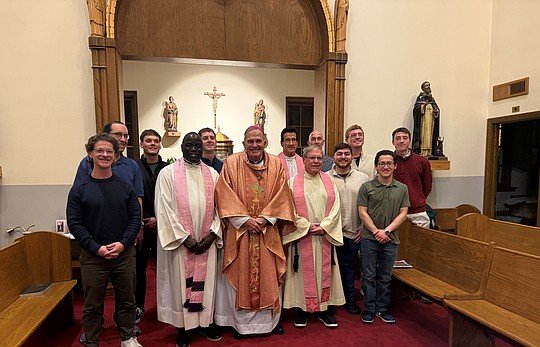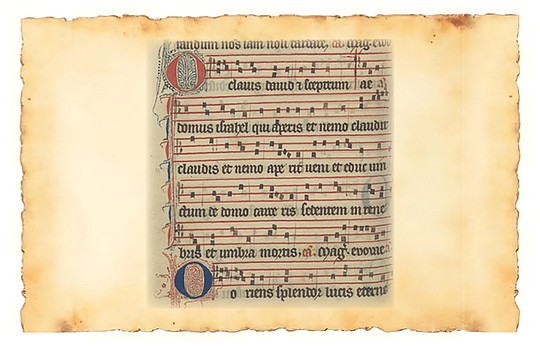New report gives insights into men and women religious making perpetual vows today
February 3, 2025 at 10:04 p.m.

OSV News – Those who embrace consecrated life "bring the hope of the Gospel to the world in both visible and hidden ways," said Bishop Earl A. Boyea of Lansing, Michigan, chairman of the U.S. Conference of Catholic Bishops' Committee on Clergy, Consecrated Life and Vocations.
Bishop Boyea shared his thoughts in a Jan. 29 statement released by the USCCB ahead of the World Day of Prayer for Consecrated Life on Feb. 2, the feast of the Presentation of Jesus in the Temple. The day of prayer for women and men in consecrated life was instituted by St. John Paul II in 1997.
 Young women religious pray during the opening Mass of the National Prayer Vigil for Life Jan. 23, 2020, at the Basilica of the National Shrine of the Immaculate Conception in Washington. The World Day for Consecrated Life -- a day of prayer for women and men religious instituted by St. John Paul II in 1997 -- is observed on the feast of the Presentation of the Lord, Feb. 2. (OSV News photo/Gregory A. Shemitz, CNS)
Young women religious pray during the opening Mass of the National Prayer Vigil for Life Jan. 23, 2020, at the Basilica of the National Shrine of the Immaculate Conception in Washington. The World Day for Consecrated Life -- a day of prayer for women and men religious instituted by St. John Paul II in 1997 -- is observed on the feast of the Presentation of the Lord, Feb. 2. (OSV News photo/Gregory A. Shemitz, CNS) Along with Bishop Boyea's statement, the USCCB also announced the release of a new report on men and women religious in the U.S. who professed their perpetual vows in 2024.
The annual survey is conducted for the bishops by the Center for Applied Research in the Apostolate at Georgetown University.
With responses from 75% of the U.S.-based institutes contacted by CARA, a total of 140 religious members – 73 sisters and nuns, and 67 brothers and priests – participated in the survey. It represents a response rate of 72% out of the 194 identified men and women religious in the profession class of 2024.
The CARA data shows that a majority of responding religious orders – 81% – had no one profess perpetual vows in 2024.
According to CARA's report, 91 women and 103 men professed perpetual vows in religious life in 2024, with an average age of 37. Their ages ranged from 25 to 69. Half of the respondents were aged 34 or younger.
Candidates who do seek consecrated religious life are ardent in faith, explained Father Jorge Torres, a priest of the Diocese of Orlando, Florida, and executive director of the USCCB's Secretariat of Clergy, Consecrated Life And Vocations.
"There are so many young people who are saying yes. They are attracted to those communities that are challenging them to live the Gospel in its fullness, and that's one thing that sometimes people may not see," Father Torres told OSV News. "Do we have the numbers that we had some generations ago? We don't, but we have great quality."
That quality includes a range of educational and life experiences prior to entrance into religious life. CARA's report on the 2024 profession class found that while on average respondents were 19 years old when they first considered religious life, almost three quarters – 73% – had earned an undergraduate or graduate degree before entering their religious institute.
"I have multiple art degrees and came back to the faith at one of the most secular art institutes in the country. God is everywhere," said Sister Mary Michael Di Palma, a member of the Sister Servants of the Eternal Word, in a statement posted to the USCCB's online profile of members from the 2024 profession class.
Trappist Sister Jennifer Illig said in her USCCB profile that she had first visited the community in 2003, but entered nine years later after earning her doctorate in theology.
At the same time, only 11% reported having their entrance to religious life delayed (generally by about three years) due to educational debt. On average, this group spent three years paying off more than $46,000 in educational debt. Family and friends were the most common form of assistance.
The CARA report also noted 82% of the respondents had prior work experience, largely in the fields of business, education and health care.
Augustinian Brother David Relstab of the Province of Our Mother of Good Counsel said in his USCCB profile that he had been a mechanic for Mercedes-Benz (a job that requires mastery of complex electronic systems), and still teaches automotive technology at a local community college.
Most (84%) respondents said they had received encouragement from someone to consider religious life, generally a religious sister or brother (59%), friend (59%) or parish priest (38%). Over half (57%) also reported being discouraged from the prospect, with women (61%) more likely than men (43%) to experience such pushback.
Well over three quarters (78%) had participated in a "come and see" vocational discernment experience.
Regarding their habits of prayer before consecrated life, CARA found going on retreat was "the most common type of formative prayer experience" for four out of five. A similar number prayed the rosary regularly before joining their religious institute. And seven out of 10 went regularly to Eucharistic adoration.
The CARA report also found:
– The majority of respondents (92%) have been Catholic since baptism shortly after birth, with 92% having at least one parent who was Catholic, while for 87% both parents were Catholic;
– Almost all (97%) respondents were raised during their formative years by their biological parents, with 90% raised by a married couple living together, with 96% also having at least one sibling;
– Over half (64%) of the respondents listed their primary race or ethnicity as Caucasian, European American, or white, with 14% identifying as Asian, Pacific Islander or Native Hawaiian; 11% as Hispanic or Latino; 6% as African, African American or Black; 5% as mixed race or other;
– Slightly less than three quarters (69%) of respondents were born in the U.S. with 12% born in Asia, 10% in Latin America and 6% in Africa.
In his statement, Bishop Boyea said that women and men in consecrated life "remind us of the deep desire of the human heart to see the face of God."
He added, "We thank them for their dedication 'to stay awake, to be vigilant, to persevere in waiting' as Pope Francis has said."
Gina Christian is a multimedia reporter for OSV News. Follow her on X @GinaJesseReina.
NOTES: To view the report on the 2024 profession class by the Center for Applied Research in the Apostolate at Georgetown University, visit https://www.usccb.org/committees/clergy-consecrated-life-vocations/profession-classes
The Church needs quality Catholic journalism now more than ever. Please consider supporting this work by signing up for a SUBSCRIPTION (click HERE) or making a DONATION to The Monitor (click HERE). Thank you for your support.
Related Stories
Monday, December 15, 2025
E-Editions
Events
OSV News – Those who embrace consecrated life "bring the hope of the Gospel to the world in both visible and hidden ways," said Bishop Earl A. Boyea of Lansing, Michigan, chairman of the U.S. Conference of Catholic Bishops' Committee on Clergy, Consecrated Life and Vocations.
Bishop Boyea shared his thoughts in a Jan. 29 statement released by the USCCB ahead of the World Day of Prayer for Consecrated Life on Feb. 2, the feast of the Presentation of Jesus in the Temple. The day of prayer for women and men in consecrated life was instituted by St. John Paul II in 1997.
 Young women religious pray during the opening Mass of the National Prayer Vigil for Life Jan. 23, 2020, at the Basilica of the National Shrine of the Immaculate Conception in Washington. The World Day for Consecrated Life -- a day of prayer for women and men religious instituted by St. John Paul II in 1997 -- is observed on the feast of the Presentation of the Lord, Feb. 2. (OSV News photo/Gregory A. Shemitz, CNS)
Young women religious pray during the opening Mass of the National Prayer Vigil for Life Jan. 23, 2020, at the Basilica of the National Shrine of the Immaculate Conception in Washington. The World Day for Consecrated Life -- a day of prayer for women and men religious instituted by St. John Paul II in 1997 -- is observed on the feast of the Presentation of the Lord, Feb. 2. (OSV News photo/Gregory A. Shemitz, CNS) Along with Bishop Boyea's statement, the USCCB also announced the release of a new report on men and women religious in the U.S. who professed their perpetual vows in 2024.
The annual survey is conducted for the bishops by the Center for Applied Research in the Apostolate at Georgetown University.
With responses from 75% of the U.S.-based institutes contacted by CARA, a total of 140 religious members – 73 sisters and nuns, and 67 brothers and priests – participated in the survey. It represents a response rate of 72% out of the 194 identified men and women religious in the profession class of 2024.
The CARA data shows that a majority of responding religious orders – 81% – had no one profess perpetual vows in 2024.
According to CARA's report, 91 women and 103 men professed perpetual vows in religious life in 2024, with an average age of 37. Their ages ranged from 25 to 69. Half of the respondents were aged 34 or younger.
Candidates who do seek consecrated religious life are ardent in faith, explained Father Jorge Torres, a priest of the Diocese of Orlando, Florida, and executive director of the USCCB's Secretariat of Clergy, Consecrated Life And Vocations.
"There are so many young people who are saying yes. They are attracted to those communities that are challenging them to live the Gospel in its fullness, and that's one thing that sometimes people may not see," Father Torres told OSV News. "Do we have the numbers that we had some generations ago? We don't, but we have great quality."
That quality includes a range of educational and life experiences prior to entrance into religious life. CARA's report on the 2024 profession class found that while on average respondents were 19 years old when they first considered religious life, almost three quarters – 73% – had earned an undergraduate or graduate degree before entering their religious institute.
"I have multiple art degrees and came back to the faith at one of the most secular art institutes in the country. God is everywhere," said Sister Mary Michael Di Palma, a member of the Sister Servants of the Eternal Word, in a statement posted to the USCCB's online profile of members from the 2024 profession class.
Trappist Sister Jennifer Illig said in her USCCB profile that she had first visited the community in 2003, but entered nine years later after earning her doctorate in theology.
At the same time, only 11% reported having their entrance to religious life delayed (generally by about three years) due to educational debt. On average, this group spent three years paying off more than $46,000 in educational debt. Family and friends were the most common form of assistance.
The CARA report also noted 82% of the respondents had prior work experience, largely in the fields of business, education and health care.
Augustinian Brother David Relstab of the Province of Our Mother of Good Counsel said in his USCCB profile that he had been a mechanic for Mercedes-Benz (a job that requires mastery of complex electronic systems), and still teaches automotive technology at a local community college.
Most (84%) respondents said they had received encouragement from someone to consider religious life, generally a religious sister or brother (59%), friend (59%) or parish priest (38%). Over half (57%) also reported being discouraged from the prospect, with women (61%) more likely than men (43%) to experience such pushback.
Well over three quarters (78%) had participated in a "come and see" vocational discernment experience.
Regarding their habits of prayer before consecrated life, CARA found going on retreat was "the most common type of formative prayer experience" for four out of five. A similar number prayed the rosary regularly before joining their religious institute. And seven out of 10 went regularly to Eucharistic adoration.
The CARA report also found:
– The majority of respondents (92%) have been Catholic since baptism shortly after birth, with 92% having at least one parent who was Catholic, while for 87% both parents were Catholic;
– Almost all (97%) respondents were raised during their formative years by their biological parents, with 90% raised by a married couple living together, with 96% also having at least one sibling;
– Over half (64%) of the respondents listed their primary race or ethnicity as Caucasian, European American, or white, with 14% identifying as Asian, Pacific Islander or Native Hawaiian; 11% as Hispanic or Latino; 6% as African, African American or Black; 5% as mixed race or other;
– Slightly less than three quarters (69%) of respondents were born in the U.S. with 12% born in Asia, 10% in Latin America and 6% in Africa.
In his statement, Bishop Boyea said that women and men in consecrated life "remind us of the deep desire of the human heart to see the face of God."
He added, "We thank them for their dedication 'to stay awake, to be vigilant, to persevere in waiting' as Pope Francis has said."
Gina Christian is a multimedia reporter for OSV News. Follow her on X @GinaJesseReina.
NOTES: To view the report on the 2024 profession class by the Center for Applied Research in the Apostolate at Georgetown University, visit https://www.usccb.org/committees/clergy-consecrated-life-vocations/profession-classes
The Church needs quality Catholic journalism now more than ever. Please consider supporting this work by signing up for a SUBSCRIPTION (click HERE) or making a DONATION to The Monitor (click HERE). Thank you for your support.










